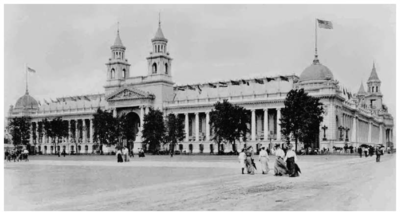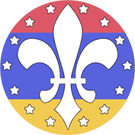Palace of Varied Industries
 | |
| Location | Main Picture |
|---|---|
| No. of Buildings | 1 |
| Construction | |
| Construction Cost | $703,815 ($21.2 million in 2021) |
| Architecture | |
| Dimensions | 1,200' x 525' |
| {{{PAGENAMEBASE}}} floorplan | |
The Palace of Varied Industries was a huge fourteen acre structure, containing a huge courtyard in its center. Built by Van Bruny & Howe of Kansas City, it used 6-7 million board feet of lumber. It was the first palace on the Main Picture to be completed.
Description
Though there were separate courtyard exhibits from Switzerland, Persia and Brazil, the palace's vast interior contained a diversified mélange of domestic and foreign displays. Fairgoers could view (as well as purchase), fine china and Persian rugs to inlayed furniture, tapestries, and jewelry.
Some of the exhibitors (such as Singer), exhibited in both the Palace of Varied Industries and its sister building Palace of Manufacturers.
Applications for both the Palace of Varied Industries and Manufacturers covered eight times their allowed space, thus making real estate at these building extremely competitive.
At night, more than 15,000 lights illuminated the palace for breathtaking evening vistas.
Notable Exhibits
The Ingersoll Watch Company, the official timekeeper of the Fair and which had thirty booths spread within the fairgrounds; had a particular striking display in the palace. They sold watches of sizes and styles, many depicted the beautiful Cascades or Festival Hall. A key-wound watch would cost on average one dollar.
The Singer Sewing Machine Company's exhibit display was partly in an enclosed pavilion with a dome. Besides displays and demonstrations of their best-selling sewing machine, the company showcased improvements such as a machine for blind stitching, one for for shoes, and a canvas-sewing machine that could make about 500 stitches a minute. In addition, a multitude of international costumes and dresses were shown, created on Singer machines.
The Eaton, Crane & Pike Company, of Massachusetts, exhibited the process of manufacturing fine stationery. From a paper-making exhibit to machinery that included cutting presses and filing machines, the company showed fairgoers the power of what large volume production could do. Included were imprinting and gold initial embossing machines.
The L.E. Waterman Company's exhibit was held up by four 20 foot high pens, acting as pillars. The average pen cost about $3.00, but the company also sold uxorious diamond studded ones for a hundred dollars.
The Standard Table Oilcloth Company displayed the first washable wall covering.
The A.S. Aloe Instrument Company, a St. Louis optical manufacturer, gave out free eye exams, while selling prescription glasses for $3.50. They also sold smoked glasses to protect fairgoers from the strong Missouri sun but were thought of a more novelty souvenir.
At the palace, one could purchase the finest Swiss watches, Persian rugs (from 5 to 2,500 dollars), watch fobs, cards, stained glass, cases and purses as well as clothing and the ever-present Fair souvenirs. There were many concessions and food emporiums for fairgoers to take a break from all the displays and walking.
On display was a drawing room table inlayed with over 40 different types of wood, forming a spectacular realistic map of the United States.
Germany exhibit: included a 25,000 dollar bronze and iron eagle, an oil painting-like inlayed landscape by Karl Spindler and elaborate art and Jewry exhibits. 31 pound radishes, 22 foot high corn stalks, a Wine Temple with over 300 varieties of wine. State seal made out of dried beans.
Kansas exhibit: included a relief of a work operating a cream separator in butter. Striking eagles, an Indian and eagles made out of corn.
Japan exhibit: included a multitude of pottery, porcelain and cloisonné, as well as carved ivory and jade. They also sold kimonos, which were becoming popular in the United States.
Denmark exhibit: included Marie Antoinette's snuff box. Antoinette was Queen of France was married to Louis XVI at the age of 14. She was beheaded in 1793 for treason. The exhibit also showcased Royal Copenhagen porcelain, founded in 1775, this exquisite china was painted cobalt blue before glazing to fuse the porcelain mass and the glaze to make Chinese style porcelain and it's trademark “blue and white style.”
France exhibit: included an 80 piece set of china valued at 12,000 dollars.
